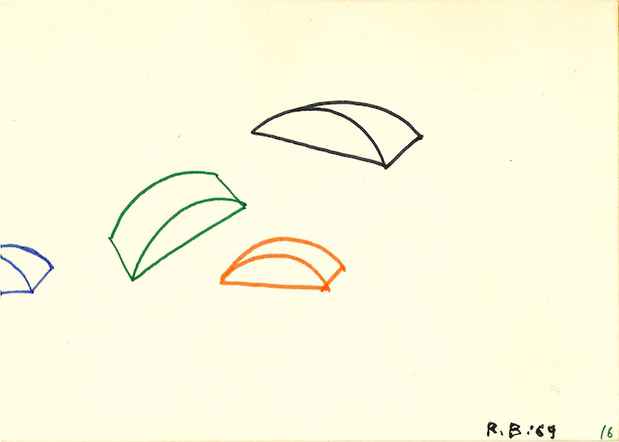"From An Object's Point Of View" Exhibition
Murray Guy

This event has ended.
Reclining, ambulating, balancing, reflecting, approaching and withdrawing, this exhibition brings together a group of objects that might propose the question: what is it like to be a thing?
The extraordinary works of Robert Breer (1926 — 2011) include sculptures, drawings, paintings, flip books, and many hand-drawn animated films. His "floats" — first produced in the early 1960s — are very slow-moving sculptures, often made from materials like Styrofoam, resin, or metal foil. They constantly rearrange themselves and their viewers as they wander through the exhibition space, bumping into walls, into each other, and into other works and objects.
The sculptures and performances of Jirí Kovanda (b. 1953) often animate familiar consumer objects (sugar cubes, ketchup bottles, flashlights, a bicycle.) Kovanda combines or uses objects "inappropriately" — for example suspending a bag of marshmallows and a hammer on either side of a long piece of twine, or inserting wooden wedges into the cracks between old paving stones. Making them speak in strange ways, his actions and interventions often endow objects with an uncanny eroticism.
The Postmodern Tragedy photographs of Mac Adams (b. 1943) show various decorative objects (a teapot, a lamp, a pastry tray) in front of monochromatic studio backdrops, while various violent activities (a shooting, an assault, a kidnapping) can be seen reflected in their metallic skins. The contradictions or interior lives of these objects speak to the moment at which they were photographed, in the late 1980s, after a decade of the polarizing economic policies of Ronald Reagan and Margaret Thatcher.
First realized at the Fondazione Morra Greco in Naples, Roman Ondák's (b. 1966) Breath on Both Sides is an inflated red balloon squeezed through a small hole in a gallery window pane, one bulbous end poking through the interior, the other enjoying outside air. Ondák frequently draws attention to the change in status objects acquire once framed by art institutions; for this work to exist, the balloon and the architecture must accept a state of co-dependence.
Traveling is a key reference in the work of Pratchaya Phinthong (b. 1974, Bangkok), as he often stages or refers to material or discursive displacements — for example, a quixotic effort to construct a house for polar bears in Chang Mai, Thailand. Phinthong's objects include an ongoing series of subtly altered, pre-made Renaissance canvases; still wrapped in their plastic packaging, they unsettle their own status and the presumed authorship or creativity of their producer.
In 2009 Mark Geffriaud (b. 1977) took an object from the home of his friend and fellow artist Eric Stephany. Both agreed that the object could stay in Geffriaud's possession as long as its owner would not be able to identify the nature of the missing thing, and this exchanged object would then constitute an artwork, entitled Cyrus. This object has been entrusted to the gallery for the duration of the exhibition, but if and when Stephany realizes the nature of the thing, it will be returned to him and will no longer constitute an artwork.
Media
Schedule
from May 11, 2012 to June 30, 2012